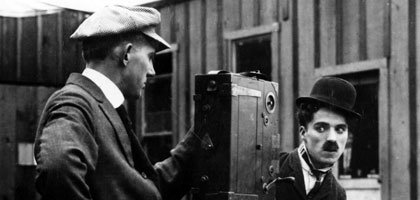Primary navigation
bfi links

The restoration of Chaplin's second Keystone Film, Kid Auto Races was made from two element held by the National Archive; a tinted print made from the original negative in 1920 and a reissue from 1916 entitled, Take my Picture.
The titles that appear in the restored National Archive print of Kid Auto Races are reconstructed from original Keystone titles. Members of the Chaplin Keystone project have researched the wording most closely resembling the original text and used it to make new titles carefully matching Keystone's graphic design.
One problem that we faced with Kid Auto Races at Venice, Cal. (to give it its full title), was confirming this original release title. While Glenn Mitchell (in his Chaplin Encyclopedia ) explains that Keystone may have released it under slightly differing titles, it seems that frequently the versions reissued by other companies under different titles (e.g. The Pest) , used the original main title as the first intertitle, to introduce the setting. It is worth remembering that this film was originally a 'candid camera' gag, in which spectators at the kids' races unknowingly participated. It was released jointly with a non-fiction Keystone film Olives and their Oil.
David Robinson's book Chaplin: The Art of Comedy reproduces a series of stills from Chaplin's personal scrapbooks. These scrapbooks are now being preserved at the Chaplin archives by the Cineteca di Bologna [link to their site]. The only Keystone film represented with an original intertitle in the scrapbooks is this one. The film's main title, which can be seen, uncharacteristically underlined at the top of the frame, is given as Kid Auto Races at Venice, Cal. This is confirmed in a section of dupe negative, held in the National Archive, struck from a Keystone print before it finally decomposed.
The second intertitle featured in the scrapbook indicates that the film originally began with an extremely long (for Keystone) explanatory intertitle explaining Chaplin's presence. The next still shows that the film began with the start of the race (material we haven't seen). We decided not to reproduce the long intertitle in the new print because it would be followed by Chaplin's appearance - a completely different context. Otherwise, we took the titles from the WH Productions' reissue The Pest .
The surprising close up of Chaplin that finishes the film appears to be missing from many copies. It was in an early reissue from 1916, titled Take My Picture . In other ways, this reissue differed a lot from the original - not least the text of the intertitles, which are written from 'Charlie's' point of view. But it contained the final shot (75 frames in total) and additional frames of the preceding shot. By carefully matching the negative contrasts, these extra frames have been cut into the new negative. The use of the close-up to end a film was common practice in films of the period, although it was dying out. The close-up effectively corresponds to the performer's curtain call as if they were on stage but it also had a function to make the 'star' recognizable in a time when presentation of film didn't always allow the audience to distinguish the actor's faces well. The device is also found in where Marie Dressler takes a bow. These end sections are frequently missing on surviving archival prints.
Originally released on February 7 1914 as a split reel with Olives and Their Oil
Original running time 572ft / 174m. Length of restored print 772ft New restored print 430ft / 130m